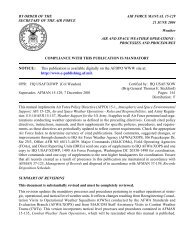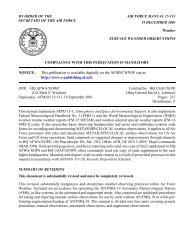Joint Metoc Handboo - IHMC Ontology and Policy Management
Joint Metoc Handboo - IHMC Ontology and Policy Management
Joint Metoc Handboo - IHMC Ontology and Policy Management
You also want an ePaper? Increase the reach of your titles
YUMPU automatically turns print PDFs into web optimized ePapers that Google loves.
2-JTF Formation <strong>and</strong> Planning<br />
Threat<br />
Identification<br />
& Assessment<br />
Strategy<br />
Determination<br />
COA<br />
Development<br />
Detailed<br />
Planning<br />
Implementation<br />
JSCP<br />
APPROVED FOR<br />
FURTHER PLANNIG<br />
DELIBERATE<br />
PLANNING<br />
PROCESS<br />
Phase II<br />
Concept<br />
Develoment<br />
Phase I<br />
Initiation<br />
Phase III<br />
Plan<br />
Development<br />
Phase IV<br />
Plan<br />
Review<br />
Phase V<br />
Supporting<br />
Plans<br />
CRISIS ACTION<br />
PLANNING PROCESS<br />
WARNING<br />
ORDER<br />
ALERT<br />
ORDER<br />
EXECUTE<br />
ORDER<br />
Phase I<br />
Situation<br />
Development<br />
Phase II<br />
Crisis<br />
Assessment<br />
Phase III<br />
COA<br />
Development<br />
Phase IV<br />
COA<br />
Selection<br />
Phase V<br />
Execution<br />
Planning<br />
Phase VI<br />
Execution<br />
Figure 2-2. JOPES Deliberate Planning Process <strong>and</strong> Crisis Action Planning Process<br />
Functional Alignment<br />
- Operation Order (OPORD). OPORDs are created during crisis action planning<br />
using prescribed formats. They are in the form of a directive issued by a<br />
comm<strong>and</strong>er to subordinate comm<strong>and</strong>s to effect the coordinated execution of an<br />
operation.<br />
• <strong>Joint</strong> Operations Planning <strong>and</strong> Execution System (JOPES). JOPES is policies <strong>and</strong><br />
procedures that guide joint operation planning efforts. Detailed policies, procedures,<br />
planning formats, <strong>and</strong> guidance are contained in JOPES Vol. I <strong>and</strong> II as referenced<br />
above.<br />
2.1.2 Crisis Action Planning (CAP) Procedures.<br />
• Phase I - Situation Development. The focus of this phase is on the combatant<br />
comm<strong>and</strong>er in whose areas the event occurs <strong>and</strong> who will be responsible for the<br />
execution of any military response. The initial report of the incident may be reported<br />
by the combatant comm<strong>and</strong>er or from the National Military Comm<strong>and</strong> Center. The<br />
supported comm<strong>and</strong>er prepares <strong>and</strong> submits an assessment of the event to the NCA <strong>and</strong><br />
the CJCS. The assessment includes amplifying information regarding the situation,<br />
actions being taken, forces available, expected time for commitment of forces, <strong>and</strong><br />
major constraints on the employment of forces.<br />
• Phase II - Crisis Assessment. The NCA, CJCS <strong>and</strong> other members of the <strong>Joint</strong> Chiefs<br />
of Staff analyze the situation through available intelligence <strong>and</strong> determine whether a<br />
2-3




